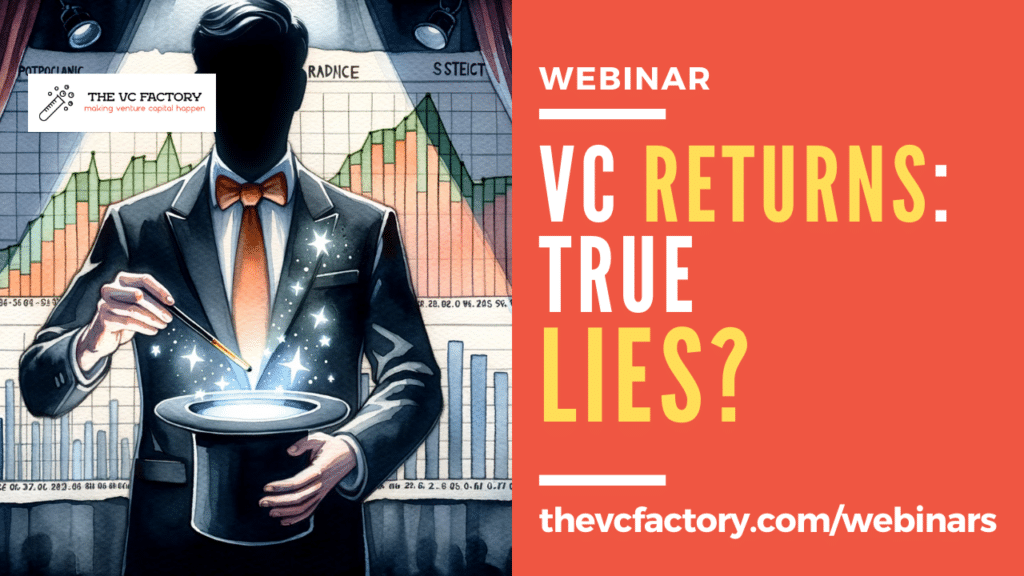Venture Capital Returns: True Lies?
- 3.3K views
- 15 minute read

The true performance of Venture Capital is often debated, and myths about it tend to persist despite recent data published by various outlets. Does VC make money as an asset class? If so, how high are Venture Capital returns, and how do they compare to other asset classes such as stocks? Given the methodologies used to value unrealized returns, does the stated performance reflect reality? Whether you run a VC fund, invest in them, raise money from them, or want to join one, you need to be familiar with these questions to make an informed decision.
In this post and the companion webinar, I explain which metrics are used to calculate the performance of Venture Capital funds, report the performance of the VC asset class and compare it to public stocks, explain how VC portfolios are valued and why Investors in VC funds need to run deep diligence to get a fair appreciation of the true performance. I round up with an analysis of write-offs about to hit Venture Capital.
In This Post
Accelerate Your Learning: Watch Our Webinar!
Don’t just read about it, immerse yourself in the content through our companion webinar for this post! Engage with a multimedia presentation, discover all the referenced sources, and have your questions answered live! Click the “Watch Now” button to access the webinar. (Members: click here).

How Venture Capital Returns Are Calculated: MOIC, IRR, TVPI, & DPI
Calculating venture capital returns can be a difficult task, but understanding the process is essential for anyone looking to invest in VC funds, take money from them, or making a career with a VC firm.
Venture Capital Returns 101: MOIC & IRR
Venture Capital returns are typically calculated using two primary metrics:
- Multiple On Invested Capital (MOIC): MOIC measures the multiple times money was returned on the original investment. It is generally measured at the Investor's liquidity event, i.e., in an exit such as an IPO or acquisition
- Internal Rate of Return (IRR): IRR is a time-weighted metric that adjusts for cash flows coming into and out of investments over time to calculate the overall rate of return.
Both metrics offer insight into return performance and can be used to assess different VC funds' performance relative to each other.
At the startup level, MOIC is calculated for each Investor by dividing their exit proceeds (the portion of the total exit price they received, net of all fees) by the amount they invested in the startup over time. If the VC fund participated in several rounds, each round will have a different performance. However, MOIC is typically calculated across all rounds.
For example, if a VC fund invested $10 million into a startup and got $45 million in an exit, the MOIC would be 4.5x ($45/$10).
At the VC fund's level, MOIC is calculated by running the same formula across all the fund's participations and weighting them for the check size. LPs receive their share net of carried and fees.
You can't eat IRR.
Howard Marks - Oaktree Capital (Source: Oaktree)
The Internal Rate of Return (IRR) is another calculation that helps Investors estimate the fund's performance. It is determined by taking into account all the cash flows associated with an investment, including capital calls or drawdown notices, distributions, and fees. IRR is calculated using the net present value (NPV) concept and is best calculated in Excel.
IRR has advantages:
- Time-weighting: IRR takes into account the timing of cash flows. It is important when comparing investments with different cash flow profiles, which is the case in VC
- Comparability: IRR is a widely recognized metric, making it easier to compare the performance of different funds or asset classes. We use IRR when comparing VC funds and stocks below
However, IRR also has limitations. Howard Marks highlights its inability to accurately portray the actual cash returns generated by an investment. In the Venture Capital context, this means that a fund with a high IRR might not necessarily deliver the highest cash returns to its LPs.
I remember colleagues of mine returning a 60% IRR on a transaction, and being upset about it. They had just committed $2 million to the startup after spending months wooing Founders and conducting due diligence. Nine months later, the Founders sold their company for an exit price that made them millions but was only marginally accretive for the fund, which netted less than 1.5x.
TVPI and DPI: Understanding the Importance of Valuing Unrealized Returns
Total Value to Paid-In Capital (TVPI) and Distribution to Paid-In Capital (DPI) are additional metrics used to assess Venture Capital fund performance.
TVPI measures the overall performance of a VC fund by combining both realized and unrealized returns, i.e., the returns of startups that exited and those still held in the portfolio. It is calculated by dividing the sum of the fund's net asset value (NAV) and the total distributions to LPs by the total amount of capital paid in by LPs. The NAV represents the unrealized portion of the fund's investments, which includes the current market value of the remaining portfolio companies.
DPI, on the other hand, measures the realized returns of a VC fund, i.e., the cash returned to LPs. It is calculated by dividing the total distributions to LPs by the total amount of capital paid in by them.
The relationship between TVPI and DPI is simple. TVPI It is calculated by dividing the sum of the fund's realized proceeds (DPI) and unrealized value (also called Residual Value to Paid-In Capital, or RVPI) by the total amount of capital paid into the fund by its LPs.
TVPI = (DPI + RVPI) / Total Paid-In Capital
The unrealized portion of TVPI, represented by RVPI, is essential in determining the potential future returns of a VC fund.
Some of these paper valuations are very very shaky.
Rob Go - Nextview (Source: Better everyday)
RVPI can be misleading for several reasons:
- Subjective valuations: The valuation of unrealized investments is often based on the most recent financing rounds or third-party appraisals. These valuations might not accurately reflect the true value of the startups in the portfolio, leading to an inflated or deflated TVPI
- Illiquid investments: Unrealized investments are, by definition, illiquid. Their value is subject to change based on market conditions, management performance, and the success of the underlying business. Relying solely on the unrealized portion of TVPI can paint an inaccurate picture of a fund's performance
- Timing: RVPI can be influenced by the timing of investments and exits. Funds that have made more recent investments may have a higher unrealized value, leading to a higher TVPI. However, this doesn't necessarily mean that the fund is performing better; it may simply indicate that the fund has not yet had the opportunity to realize gains on its investments.
In the webinar, I illustrate these metrics using real VC portfolios including Kima Ventures and Version One Ventures.
Now that we're all on the same page regarding VC funds metrics, let's take a look at the long-term performance of Venture Capital.
How Does Venture Capital Perform As An Asset Class?
Amidst the confusion and myths surrounding the long-term performance of Venture Capital, it's essential to shed light on how this asset class has fared over time and how it compares to other investment options. In the following section, I unravel the complexities and provide clarity on the performance of VC investments.
Venture Capital Returns: A 30-Year View
In the webinar, I explore the long-term performance trends of the VC asset class, using data from a comprehensive Cambridge Associates report covering vintages from 1981 to 2015. A fund vintage refers to the year in which a fund was launched and began making investments. Vintage is an important parameter to consider when analyzing VC funds because it helps to account for differences in market conditions, technological trends, and economic cycles that can significantly impact investment performance:
- Economic conditions vary over time, and different vintages may be exposed to different phases of the economic cycle, such as growth or recession. Comparing the performance of funds from the same vintage helps to isolate the effects of these macroeconomic factors and assess the relative performance of fund managers under similar market conditions
- Technological and market trends evolve over time, leading to the emergence of new industries and the decline of others. Vintage analysis enables investors to compare the performance of funds that have invested in similar technological trends, providing insight into which fund managers have been successful at identifying and capitalizing on emerging opportunities
- By analyzing the performance of funds across multiple vintages, investors can assess the track record of fund managers and identify those who consistently deliver strong returns over time. This information can be valuable when deciding which funds to invest in or partner with
- Different vintages may be associated with distinct investment strategies, such as early-stage investing, growth-stage investing, or specific sector focuses. Vintage analysis can help investors understand the effectiveness of these strategies over time and inform their own investment decisions.
Comparing TVPI and DPI brings to light the differences between realized and potential returns mentioned before. Additionally, I examine the performance variations between median and upper quartile funds reported by Cambridge Associates, offering insights into the factors driving top-tier results.
One takeaway is the power law's role in shaping Venture Capital returns, and how it influences the distribution of outcomes for both investors and startups. Through this analysis, you'll gain a deeper understanding of the forces at play in the VC landscape and how VC performs through long-term trends.
Venture Capital vs. Public Stocks vs. Private Equity
Researchers and practitioners are interested in comparing Venture Capital returns with the performance of other asset classes, such as public stocks, to understand the risk and return profile of VC investments relative to more traditional and liquid investment opportunities. This comparison provides valuable insights for LPs, such as pension funds and endowments, who are considering allocating capital to the VC asset class. They can assess whether the higher risk, illiquidity, and longer investment horizon associated with VC investments are justified by the potential for higher returns.
One commonly used method for comparing VC returns to public stocks is the Public Market Equivalent (PME). The PME is a performance measurement tool that allows Investors to compare the performance of a VC fund with that of a public market index, such as the S&P 500, to determine if the fund has generated returns in excess of what would have been achieved by investing in the public market.
The seminal work by Stephen Kaplan and Antoinette Schoar significantly contributed to the understanding of PME and the comparison of Venture Capital performance with public markets. The PME is calculated by dividing the total value of the VC fund (realized and unrealized returns) by the total value of a hypothetical investment in the public market index, made using the same cash flow timings and amounts as the VC fund.
Half of all venture funds outperform the stock market, which is the benchmark most institutions measure VC funds against.
Fred Wilson - Union Square ventures (source: his awesome blog)
Several articles and research papers have been published on the PME and the comparison of VC versus public stock performance. These studies often show that top-tier Venture Capital funds outperform public markets, while the median or average VC fund may underperform. This reinforces the importance of thorough due diligence and careful selection of Venture Capital funds for Investors seeking to benefit from the potential outperformance of the VC asset class.
Using the latest data available from Cambridge Associates, Silicon Valley Bank (RIP), and academic researchers, I answer the following questions in the webinar:
- How does Venture Capital perform compared to public stock indexes over short-term and long-term periods (6 months to 25 years)?
- What are the average PME and yearly variations over the last 30 years?
- Is there a top quartile effect, i.e., do only the top-tier fund overperform stock indexes?
One conclusion I draw from this analysis is that LPs who commit to the VC asset class should persist despite bad vintages and internal struggles. As the Calpers misadventure demonstrated, missing out on fund vintages can be costly. The largest public pension plan in the U.S. returns a meager 0.49% from its VC investments.
In the webinar, I also report comparative returns of VC vs. other sub-asset classes of Private Equity, such as buyout and growth/expansion funds.

Watch the webinar for a detailed analysis of VC returns (Members: click here)
You've reached a Members-only area.
Unlock Full Access
Discover exclusive content curated for Venture Capital professionals and enthusiasts. Join our community and gain unlimited access to in-depth articles, expert guest interviews, MBA-level webinars, and networking opportunities.
Register for our 7-Day Free Trial: Click Here
Already a member? Please Log In Below:
Subscribe to our Newsletter
Join 12,000+ VCs & Founders globally who enjoy our weekly digest on Venture Capital. We keep your information confidential and you can unsubscribe at any time. Sweet!
